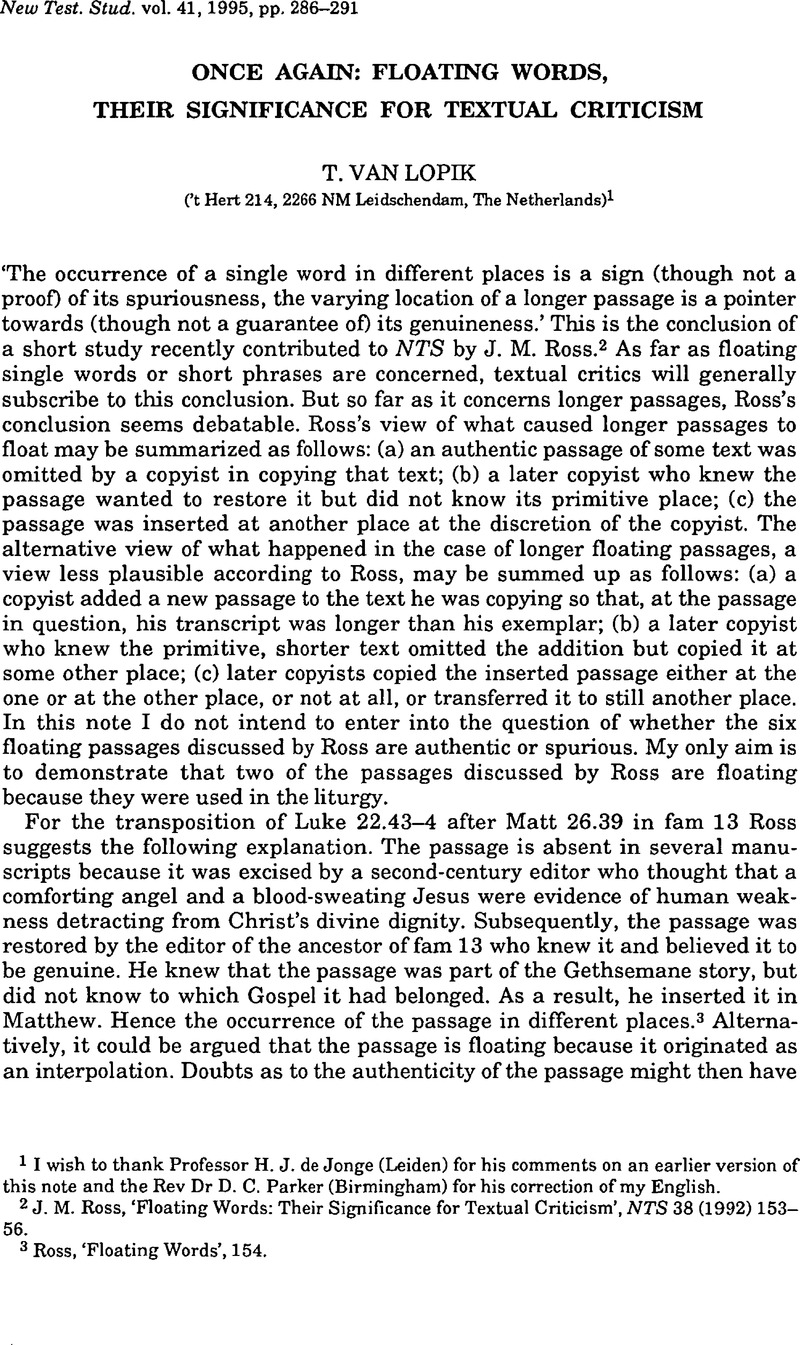Article contents
Once Again: Floating Words, Their Significance for Textual Criticism
Published online by Cambridge University Press: 05 February 2009
Abstract

- Type
- Short Studies
- Information
- Copyright
- Copyright © Cambridge University Press 1995
References
2 Ross, J. M., ‘Floating Words: Their Significance for Textual Criticism’, NTS 38 (1992) 153–56.CrossRefGoogle Scholar
3 Ross, ‘Floating Words’, 154.
4 Metzger, B. M., A Textual Commentary on the Greek New Testament (London: UBS, 2nd ed. 1975) 177Google Scholar; Aland, K. and B., Der Text des Neuen Testaments (Stuttgart: Deutsche Bibelgesell-schaft, 2nd ed. 1989) 314Google Scholar; Ehrcnan, B. D. and Plunkett, M. A., ‘The Angel and the Agony: the Textual Problem of Luke 22: 43–44’, CBQ 45 (1983) 416Google Scholar. For a different view taken by Metzger and K. and B. Aland, see next note.
5 The liturgical background to the transposition of the passage in fam 13 is referred to by, inter alios, Griesbach, J. J., Novum Testamentum Graece 1 (3rd ed.; edited by Schulz, D.; Berlin: Laue, 1827)Google Scholar at Luke 22.43; ‘Nestle, Eb., Einführung in das griechische Neue Testament (Göttingen: Vandenhoeck & Ruprecht, 2nd ed. 1899) 229–30Google Scholar; Vogels, H. J., Handbuch der neutestamentlichen Textkritik (Münster: Aschendorf, 1923) 82Google Scholar; and more recently by Du-placy, J., ‘L’histoire la plus ancienne et la forme originale du texte en Luc 22,43–44’, Études de critique textuelle du Nouveau Testament (ed. Delobel, J.; Leuven: University, 1987) 354Google Scholar; Metzger, B. M., ‘Greek Lectionaries and a Critical Edition of the Greek New Testament’, Die alten Übersetzungen des Neuen Testaments, die Kirchenvaterzitate und Lektionare (ed. Aland, K.; Berlin: De Gruyter, 1972) 495Google Scholar; and Nestle-Aland, , Novum Testamentum Graece (Stuttgart: Deutsche Bibelstiftung, 1993)Google Scholar [NA27] at Matt 26.39: 'hic add. L 22,43–44 Cmgƒ13pc (ex lect.)’.
6 Өεῖ;ον καὶ ίύαγγέλτον öμοιονκατà πàνταπρός τό àναινωσκόμενον ταῖς έκκλησίαις ('Aθθῆναι: 'Aποστολικὴ ∆ιακωία, 2nd ed. 1982) 391–8; Gregory, C. R., Textkritik des Neuen Testamentes (Leipzig: Hinrichs, 1900–1909) 362.Google Scholar
7 Eύαγγέλιον, 330–2; Gregory, Textkritik, 361.
8 Eύαγγέλιον, 323–4; Gregory, Textkritik, 360.
9 Eύαγγέλιον, 277–80; Gregory, Textkritik, 357.
10 J. Duplacy, ‘L’histoire’, 354–5.
11 The members of fam 13 are: 13 (XIII), 69 (XV), 124 (XI), 174 (1052), 230 (1013), 346 (XII), 543 (XII), 788 (XI), 826 (XII), 828 (XII), 983 (XII), 1689 (1200), 1709 (X).
12 See the descriptions in the lists of minuscules in C. R. Gregory, Prolegomena [Vol. 3 of Tischendorf, C., Novum Testamentum Graece. Ed. 8a critica maior] (Leipzig: Hinrichs, 1894)Google Scholar ad loc; idem, Textkritik, ad loc.
13 J. Duplacy, ‘L’histoire’, 352–4.
14 The obeli in 230 are mentioned in The New Testament in Greek. The Gospel according to St Luke (ed. American and British Committees of the International Greek New Testament Project; Oxford: Clarendon, 1984–1987)Google Scholar [TNTIG] ad loc.
15 For 125, 131 and 180, see J. J. Griesbach, Novum Testamentum, at Matt 26.39. From Griesbach's silence at Luke 22.43–4 I conclude that the passage occurs there too.
16 713 does not have the passage in Luke, see TNTIG, ad loc. J. Duplacy, ‘L'histoire’, 352 is incorrect, 357 is correct.
17 An early witness containing the lesson of Maundy Thursday composed from three different Gospels is 146, a 9th-century purple lectionary with golden characters, produced in an imperial school. See Weitzmann, K., ‘Ein kaiserliches Lektionar einer byzantinischen Hof-schule’, Festschrift Karl M. Swoboda zum 28. Januar 1959 (Wien: Rohrer, 1959) 309–20Google Scholar, ill. nrs 73–7; for a collation of the 19 lessons of this lectionary see Alter, F. C., Novum Testamentum 1 (Wien: Trattnern, 1787) 1069–78.Google Scholar
18 Gregory, Prolegomena, 366–9; idem, Textkritik, 40–2. Gregory's description and dating of the correctors of C, based on Tischendorf s Codex Ephraemi Syri Rescriptus sive Fragmenta Novi Testamenti (Leipzig: Tauchnitz, 1843)Google Scholar is still regarded as correct. See K. Junack, ‘Zu den griechischen Lektionaren und ihrer Uberlieferung der katholischen Briefe’, Die alten über-setzungen, 514–15.
19 Eύαγγέλιον, 229–30; Gregory, Textkritik, 355.
20 Ross, ‘Floating Words’, 155.
21 Wallace, D. B., ‘Reconsidering “The Story of Jesus and the Adulteress Reconsidered”’, NTS 38 (1993) 292.Google Scholar
22 Alter, Novum Testamentum 1, 555, 628.
23 Evύαγγέλιον, 48–52; Gregory, Textkritik, 345.
24 Wallace, ‘Reconsidering’, 292, note 5.
25 EEύαγγέλιον, 583; Gregory, Textkritik, 385.
26 See Junack, K., ‘Bibelhandschriften’, Theologische Realenzyklopadie 6 (Berlin: De Gruy-ter, 1980) 129.Google Scholar
27 Inter alios Metzger, Textual Commentary, 221.
28 Metzger, ‘Greek Lectionaries’, 495; Wikgren, A., ‘Chicago Studies in the Greek Lectionary of the New Testament’,Biblical and Patristic Studies in Memory of Robert Pierce Casey (ed. Birdsall, J. N. and Thomson, R. W.; Freiburg: Herder, 1963) 96,119.Google Scholar
- 2
- Cited by




